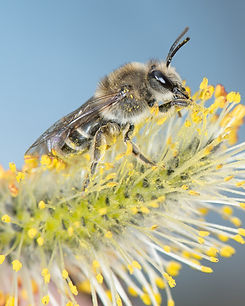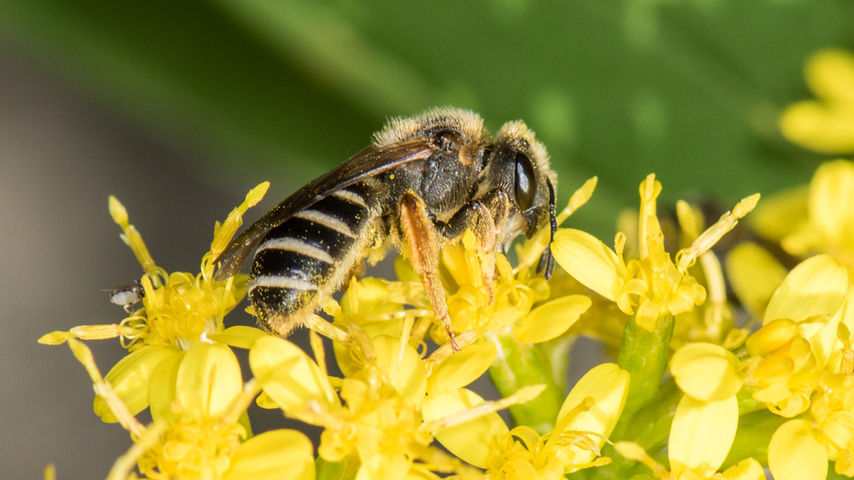
Family Halictidae > Genus Halictus
Halictus
Sweat Bees
In Minnesota, there are four described species within the genus Halictus. Bees in this genus nest in the ground and have social nests. Halictus have a dark gray or black integument and complete (uninterrupted) apical hair bands on the rims of the abdominal tergites (segments). They are small- to medium-sized, and range in length from 7 to 13 mm (0.25 to 0.5 inches).
Halictus closely resemble bees in the genus Lasioglossum. However, Halictus are generally larger, more robustly-shaped, and have complete apical abdominal hair bands (as opposed to the basal hair bands for the majority of Lasioglossum). Halictus commonly land on human skin to feed on sweat and can be attracted to mineral-rich liquids such as urine.

A Halictus ligatus female visiting Rudbeckia hirta.

wing
position
on flowers

N0. species in MN
4
size range

Phenology

Genus Characteristics

Males with a yellow labrum, yellow or orange legs with distinct dark markings on the tibiae, a linear form, long antennae, and apical hair bands.

Complete apical white hair bands on the apices (rims) of the abdominal tergites (segments).

Females collect pollen on hind leg scopae located on the femur, tibia, and basitarsus.

Females commonly feed on sweat from human skin. Both males and females with dark eyes.
Distribution

Halictus confusus

Halictus ligatus

Halictus parallelus

Halictus rubicundus
Halictus Species in Minnesota
Scientific Name | Nest | Sociality |
|---|---|---|
Halictus confusus | ground | eusocial |
Halictus ligatus | ground | eusocial |
Halictus parallelus | ground | eusocial |
Halictus rubicundus | ground | eusocial |
Source: Minnesota Department of Natural Resources, Minnesota Bee Species List (August 2023).
https://files.dnr.state.mn.us/eco/mcbs/mn-statewide-bee-list.pdf

Halictus ligatus female visiting Coreopsis lanceolata
Explore More Halictidae Genera
Explore Bee Families

Apidae
15 genera, 133 species
Bumble bees Bombus
Longhorn bees
Epimelissodes, Eucera, Melissodes
Carpenter bees
Ceratina, Xylocopa
Honey bees Apis
Digger bees Anthophora
Cuckoo bees Brachymelecta, Epeolus, Holcopasites, Nomada, Neolarra, Triepeolus
Squash bees Xenoglossa

2 genera, 39 species
Halictidae
10 genera, 133 species
Metallic green sweat bees
Agapostemon, Augochlora, Augochlorella, Augochloropsis
Large sweat bees
Dieunomia, Nomia
Short-faced bees Dufourea
Sweat bees Halictus
Small sweat bees Lasioglossum
Cuckoo (blood) bees Sphecodes
Megachilidae
14 genera, 86 species
Resin and pebble bees Anthidiellum, Dianthidium, Heriades, Paranthidium
Carder bees Anthidium, Pseudoanthidium
Mock orange bees Chelostoma
Mason bees Osmia, Hoplitis
Leafcutter bees Megachile
Sharp-tailed cuckoo bees Coelioxys
Dark cuckoo bees Stelis

Citations and Further Reading
Droege, S., et al. (2024). The Very Handy Bee Manual: 2.0. How to Catch and Identify Bees and Manage a Collection.
Gibbs, J., Hanuschuk, E., Miller, R., Dubois, M., Martini, M., Robinson, S., ... & Onuferko, T. M. (2023). A checklist of the bees (Hymenoptera: Apoidea) of Manitoba, Canada. The Canadian Entomologist, 155, e3.
Mitchell, T. B. (1960). Bees of the eastern United States. Technical Bulletin No. 141. North Carolina Agricultural Experiment Station.
Portman, Z. M., Gardner, J., Lane, I. G., Gerjets, N., Petersen, J. D., Ascher, J. S., ... & Cariveau, D. P. (2023). A checklist of the bees (Hymenoptera: Apoidea) of Minnesota. Zootaxa, 5304(1), 1-95.
Wilson, J. S., & Messinger Carril, O. J. (2016). The bees in your backyard: a guide to North America's bees. Princeton University Press.





























